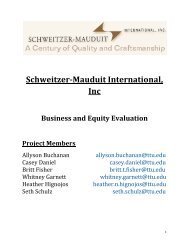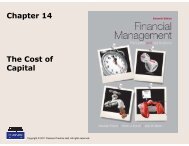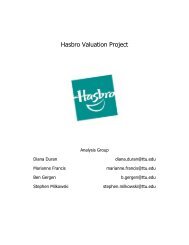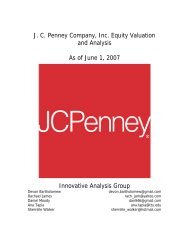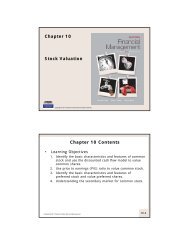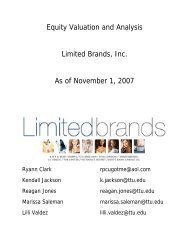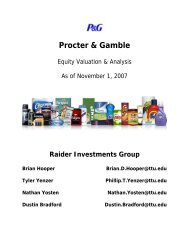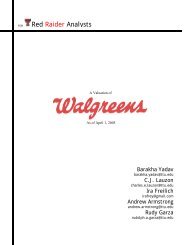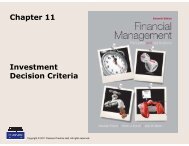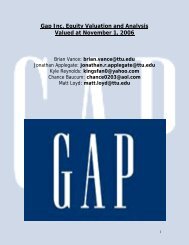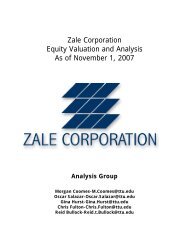Business Valuation of Polo Ralph Lauren Corporation - Mark Moore ...
Business Valuation of Polo Ralph Lauren Corporation - Mark Moore ...
Business Valuation of Polo Ralph Lauren Corporation - Mark Moore ...
- No tags were found...
Create successful ePaper yourself
Turn your PDF publications into a flip-book with our unique Google optimized e-Paper software.
<strong>Business</strong> <strong>Valuation</strong> <strong>of</strong> <strong>Polo</strong> <strong>Ralph</strong> <strong>Lauren</strong> <strong>Corporation</strong>NYSE-RLAs <strong>of</strong> April 1 <strong>of</strong> 2005<strong>Ralph</strong> <strong>Lauren</strong>Chairman and Chief Executive Officer<strong>Polo</strong> <strong>Ralph</strong> <strong>Lauren</strong>Gerald M. ChaneySenior Vice President <strong>of</strong> Finance and Chief Financial Officer<strong>Polo</strong> <strong>Ralph</strong> <strong>Lauren</strong><strong>Mark</strong> <strong>Moore</strong>Financial Statement Analysis InstructorTexas Tech UniversityPrepared By:Team AmericaStephen H. JohnstonStephen23john@aol.comTara WatkinsTara.c.watkins@ttu.eduColby WrightColbygwright@hotmail.com_____________________________________________________________________The information contained herein is <strong>of</strong> a confidential nature and is intended for the exclusive use <strong>of</strong> thepersons or firm for who it was prepared. Reproduction, publication, or dissemination <strong>of</strong>all or portions here<strong>of</strong> may not be made without prior approval from Team America.1
______________________Table <strong>of</strong> Contents______________________Executive Summary 3-4Assumptions and Limiting ConditionsIndustry Overview and Analysis 5Company Identification 5Nature and History <strong>of</strong> the Company 5<strong>Business</strong> Summary 6Products and Services 7Competitors 8SWOT AnalysisStrengths 9Weaknesses 10Opportunities 10Threats 11Five Forces ModelRivalry among Firms 12Threat <strong>of</strong> New Entrants 12Threat <strong>of</strong> Substitute Products 12Bargaining Powers <strong>of</strong> Buyers 13Bargaining Powers <strong>of</strong> Suppliers 13Accounting Analysis <strong>of</strong> Firm and IndustryKey Accounting Policies 14Ratio Analysis 22Analysis <strong>of</strong> Competitors 24Financial Statement Forecasting Methodology 26Equity <strong>Valuation</strong>s 29References 37Appendix 382
Executive SummaryThe objective <strong>of</strong> this report is to Estimate <strong>Polo</strong> <strong>Ralph</strong> <strong>Lauren</strong>s’ Fair <strong>Mark</strong>et Value <strong>of</strong>Common Stock as <strong>of</strong> the first quarter <strong>of</strong> 2005.The purpose <strong>of</strong> this report is to deicide if <strong>Polo</strong> <strong>Ralph</strong> <strong>Lauren</strong> would be a good financialinvestment and where the company’s future looks like.To come to a conclusion with the future <strong>of</strong> <strong>Polo</strong> RL we proceeded to:• Collect relevant historical statements.• Analyzed these statements and placed them into ratio form for basis to compare tothe industry.• We used the historical information and information from the company’s website,located at www.<strong>Polo</strong>.com, and at www.marketguide.com, to prepare a 3 yearprojection <strong>of</strong> the income statement, balance sheet, retained earning statement, andthe cash flow statement• We also collected information on the industry that <strong>Polo</strong> <strong>Ralph</strong> <strong>Lauren</strong> operates inand collected information on the competition <strong>of</strong> the retail/apparel industry.Used information available to me to establish a method to value the companyRecommendation- <strong>Mark</strong>et Performer, slightly overvaluedWe have initiated coverage on <strong>Polo</strong> <strong>Ralph</strong> <strong>Lauren</strong> (RL) with a recommendation to buy.With the performance <strong>of</strong> the stock in the last five years, the recent growth overseas aswell as the stronghold they continue to maintain in the United States this stock is a strongsteady investment with growth opportunities.The apparel / accessory industry has been quite competitive in the past with <strong>Polo</strong> theleader in the higher end quality merchandise. <strong>Polo</strong> has a strong market share in the U.S.industry, and expects to continue the steady growth that it has maintained in the past.<strong>Polo</strong> sees large pr<strong>of</strong>its coming from its recently expanded with its Internet sales, and thesales <strong>of</strong> overseas department stores.Industry Demand DriversThe drivers for new growth will continue with sales overseas, internet sales, and thereduction in cost due to production in China, and other overseas manufactures.In addition the increase in sales due to the increase in market share, and new demand forthe quality product that <strong>Polo</strong> has maintained year in and year out.<strong>Polo</strong> is well positioned3
With <strong>Polo</strong> entering new markets such as home decor like bedding, bath products,furniture, fabric, and wall paper, they continue to contain the strength that they haveshown in the past, and began to grasp these new markets with the strong brand name andquality product. <strong>Polo</strong> also is ahead <strong>of</strong> the industry in their production and manufacturingbeing done overseas and in various places around the globe. They currently have severalmanufacturing plants located in China which is an advantage over the competitors as theregulating laws will soon be changing.Margin Expansion<strong>Polo</strong> has maintained steady growth, and could see some margin expansion due to thestrength <strong>of</strong> the sales overseas in the Europe and Chinese markets.Healthy Financials<strong>Polo</strong> has maintained the growth in the company as net income has increased every yearexcept in 2001, when they proceeded to pay <strong>of</strong>f their total debt which was their 1997 line<strong>of</strong> credit worth $225 million as well as their 1999 which was $300 million but wasincreased to $375 million. <strong>Polo</strong> has very little debt on their balance sheet, and haveavailable credit if needed.<strong>Valuation</strong>Based on our valuation models, <strong>Polo</strong> <strong>Ralph</strong> <strong>Lauren</strong>’s stock price is very comparable toseveral <strong>of</strong> our valuation models; it is slightly overvalued that is still outperforming themarket. The actual market price was $38.41, our best valuation is our AbnormalEarnings Growth model that valued the company at $38.11 which considering <strong>Polo</strong> doesnot pay very high dividends if the pay them at all this would be the best model to use.Most <strong>of</strong> our valuation models were within the 52 week range <strong>of</strong> prices, except for ourdiscounted dividend model which would be obviously be undervalued considering <strong>Polo</strong>has only paid a dividend in the last 6 quarters.Looking Good on Other Criteria<strong>Polo</strong> is a well established company with a strong steady growth, its corporate structure isvery strong with little to no debt, and has a constant growth in its stock value, that hasoutperformed the market. It showed little to no dip or slowed growth due to the tragedy<strong>of</strong> 9/11 as well as the economic downfall that followed that <strong>of</strong> 9/11.RisksThe greatest risk that <strong>Polo</strong> RL posses right now is the law suit that they are currentlyinvolved in with Jones New York concerning a breach <strong>of</strong> licensing agreement. If JonesNew York does potentially win this lawsuit then it could cost <strong>Polo</strong> RL $343 million incash, which would potentially hurt the net income <strong>of</strong> next years earnings, but could befinanced with the two revolving lines <strong>of</strong> credit that they have available. Also they havethe seasonal department store challenges, with both competitors Tommy Hilfiger and LizClabourne introducing new styles and lines <strong>of</strong> clothes4
Industry Overview and Analysis.Company Identification<strong>Polo</strong> <strong>Ralph</strong> <strong>Lauren</strong> <strong>Corporation</strong> (NYSE:RL) is located at 650 Madison AvenueNew York, NY 10022, and was incorporated in New York as well.Nature and History <strong>of</strong> the CompanyWhat started with a tie 35 years ago has grown into an entire world that hasredefined the “American Style”. <strong>Polo</strong> has always been about selling quality products byintroducing style and inviting customers to follow. <strong>Polo</strong> was the first to create lifestyleadvertisements that told a story. <strong>Polo</strong> was the first to create stores that enabled theircustomers to interact with a Lifestyle. They continue to lead the industry today as theyhave expended world wide with the opportunities <strong>of</strong> <strong>Polo</strong>.com where across the worldyou can read about adventure, style and culture. <strong>Polo</strong> <strong>Ralph</strong> <strong>Lauren</strong> was established in1967 as <strong>Ralph</strong> <strong>Lauren</strong> created the <strong>Polo</strong> label with an instantly successful line <strong>of</strong> ties. The1970s open with the introduction <strong>of</strong> <strong>Ralph</strong> <strong>Lauren</strong> women’s wear. <strong>Lauren</strong> creates a daringline <strong>of</strong> men’s tailored shirts for women—reinventing a classic men’s look for women’sstyle. The women’s line also brings the birth <strong>of</strong> the polo player emblem. The early 70’salso brought the first polo store. The 1980’s followed just as strong as a New York Timesarchitecture critic Paul Goldberger states that the true design symbol <strong>of</strong> the 1980s was notPhilip Johnson or Robert Stern—but <strong>Ralph</strong> <strong>Lauren</strong>. The growth still increased as the1990’s passed. In 2000 the internet brought a great increase in sales.<strong>Business</strong> Summary:<strong>Polo</strong> <strong>Ralph</strong> <strong>Lauren</strong> <strong>Corporation</strong> is a leader in the design, marketing anddistribution <strong>of</strong> premium lifestyle brands <strong>of</strong> clothing and accessories, home furnishings,5
and fragrances. For more than 35 years, <strong>Polo</strong>’s reputation and distinctive image havebeen consistently developed across an expanding number <strong>of</strong> products, brands andinternational markets. The company’s brand names constitute one <strong>of</strong> the world’s mostwidely recognized families <strong>of</strong> consumer brands.Located in prime retail areas, the Company's 110 full-price stores operate underthe names <strong>Polo</strong> <strong>Ralph</strong> <strong>Lauren</strong>, Club Monaco and Club Monaco Caban. <strong>Polo</strong> <strong>Ralph</strong><strong>Lauren</strong> stores feature the full-breadth <strong>of</strong> the <strong>Ralph</strong> <strong>Lauren</strong> apparel, accessory and homeproduct assortments in an atmosphere consistent with the distinctive attitude and luxurypositioning <strong>of</strong> the <strong>Ralph</strong> <strong>Lauren</strong> brand. The Company grants product and internationallicensing partners the right to manufacture and sell at wholesale specified products underone or more <strong>of</strong> its trademarks. Its international licensing partners produce and sourceproducts independently, as well as in conjunction with <strong>Polo</strong> and its product licensingpartners.6
Products and Services:<strong>Polo</strong> <strong>Ralph</strong> <strong>Lauren</strong> designs, markets and distributes luxury products domesticallyand globally. The company’s brand names include <strong>Polo</strong> by <strong>Ralph</strong> <strong>Lauren</strong>, <strong>Ralph</strong> <strong>Lauren</strong>Purple Label, <strong>Ralph</strong> <strong>Lauren</strong>, Black Label, Blue Label, <strong>Lauren</strong> by <strong>Ralph</strong> <strong>Lauren</strong>, <strong>Polo</strong>Jeans Co., RRL, RLX, Rugby, RL Children’s wear, Chaps and Club Monaco. Thecompany <strong>of</strong>fers, along with its licensing partners, broad lifestyle product collections infour categories: apparel, which includes collections <strong>of</strong> men's, women's and children'sclothing; home, which includes coordinated products for the home, such as bedding andbath products, furniture, fabric and wallpaper, paints, broadloom, tabletop and giftware;accessories, which encompass products such as footwear, eyewear, jewelry and leathergoods, including handbags and luggage, and fragrance and skin care, <strong>of</strong> which productsare sold under the Glamorous, Romance, <strong>Polo</strong>, <strong>Lauren</strong>, Safari and <strong>Polo</strong> Sport brands. TheCompany operates in three integrated business segments: wholesale, retail and licensing.7
Distribution is accomplished at a domestic and international level with methods includingretail, wholesale, online, and in stores.Competitors:Tommy Hilfiger <strong>Corporation</strong> (THC), through its subsidiaries, designs, sources andmarkets men's and women's sportswear, jeans wear and children’s wear under theTommy Hilfiger trademarks. Through a range <strong>of</strong> strategic licensing agreements, theCompany also <strong>of</strong>fers related apparel, accessories, footwear, fragrance and homefurnishings. Its products can be found in department and specialty stores throughout theUnited States, Canada, Europe, Mexico, Central and South America, Japan, Hong Kong,Australia and other countries in the Far East, as well as the Company's own network <strong>of</strong>specialty and outlet stores in the United States, Canada and Europe. The Companypositions its apparel collections under three primary labels: H Hilfiger, Tommy Hilfigerand Tommy. THC is engaged in three segments: Wholesale, Retail and Licensing.Liz Claiborne Inc. (LIZ) designs and markets branded women's and men's apparel,accessories and fragrance products. The Company operates in three business segments,such as Wholesale Apparel, Wholesale Non-Apparel and Retail. Its portfolio <strong>of</strong> brandsincludes most apparel and non-apparel categories, reaching consumers <strong>of</strong> various age,gender, size, attitude, shopping or value preference. These products range from classicand traditional apparel to modern and contemporary wear. The Liz Claiborne's brands areavailable at over 30,000 different retail locations throughout the world, including theCompany's own specialty retail and outlet stores, and on its e-commerce sites. During2004, the international sales represented 24.4% <strong>of</strong> the Company's total sales.The Gap, Inc. (GPS) is a global specialty retailer selling casual apparel, accessories andpersonal care products for men, women and children under a variety <strong>of</strong> brand names,including Gap, Banana Republic and Old Navy. The Company's markets consist <strong>of</strong> theUnited States, Canada, Europe and Japan. Gap sells its products through both traditionalretail stores and online stores. During the fiscal year ended January 31, 2004, the8
Company-operated a total <strong>of</strong> 3,022 store locations. Its stores <strong>of</strong>fer a shopper friendlyenvironment with an assortment <strong>of</strong> casual apparel and accessories that emphasize style,quality and good value. The Company's stores are open seven days per week and on mostholidays. All sales are tendered for cash, personal checks, debit cards or credit cards,including Gap, Banana Republic and Old Navy private-label credit cards that are issuedby a third party.SWOT AnalysisStrengths:<strong>Polo</strong> <strong>Ralph</strong> <strong>Lauren</strong>’s strengths lie in its brand equity, infrastructureimprovements, its history, and it’s financial strength.High Brand Recognition: <strong>Ralph</strong> <strong>Lauren</strong>’s brand name and <strong>Polo</strong>’s logo are bothrecognizable and highly regarded in the fashion world. <strong>Polo</strong> <strong>Ralph</strong> <strong>Lauren</strong>’s classic stylehas allowed the company to expand its product portfolio into markets beyond clothing,and into apparel, scents, and home furnishings. High customer loyalty allows for a largerpr<strong>of</strong>it margin than most other companies in its industry. The powerful brand equityresponsible for such a strong consumer following reduces the price sensitivity for retailsales, which was a strong factor in maintaining good performance during the recentrecession.Infrastructure Improvement: <strong>Polo</strong> <strong>Ralph</strong> <strong>Lauren</strong> has been finding new ways to reducecosts through changes in its infrastructure, primarily in Europe. Sales in Europe haveshown little growth, but several distribution centers have been consolidated to increaseefficiency and growth. New cross-stocking merchandise methods at the North Americandistribution center in North Carolina have reduced costs for American distribution.Respectable History and Future: By consistently setting the fashion standard for threedecades, <strong>Polo</strong> <strong>Ralph</strong> <strong>Lauren</strong>’s products remains in high demand and new fashion lines areanticipated among customers.9
Debt Ratio: <strong>Polo</strong> <strong>Ralph</strong> <strong>Lauren</strong> has a low debt to capital ratio that provides financialstrength, which allows for future growth. <strong>Polo</strong> recently in 2002 paid <strong>of</strong>f their revolvingline <strong>of</strong> credit <strong>of</strong> 3 million dollars to become clear <strong>of</strong> any type <strong>of</strong> bank loans or loan ablefunds.Weaknesses:<strong>Polo</strong>’s weaknesses are in its dependence on department store sales andmanufacturing.Dependence on Department Stores: Sales from department stores make up for almost onethird <strong>of</strong> <strong>Polo</strong> <strong>Ralph</strong> <strong>Lauren</strong>’s revenues. Sales in department stores can be uncertain due toshared housing with competitors and the financial stability <strong>of</strong> these stores.Dependence on Manufacturing: Competition for quotas and capacity from other clothingmanufacturers has resulted in limitations with manufacturing for situations <strong>of</strong> highdemand. Product quality is also a factor hindered by manufacturing, due to the highstandards <strong>of</strong> the <strong>Polo</strong> fashions. <strong>Polo</strong>’s designs sometimes create new methods for qualitywith manufacturing, which hinder future growth.Opportunities:<strong>Polo</strong>’s opportunities for growth include brand extension, specialty retail, andinternational expansion.Building and Extending the Brand: <strong>Polo</strong> <strong>Ralph</strong> <strong>Lauren</strong> is one <strong>of</strong> the world's premierbrands, universally recognized and associated with distinct design, luxury and quality.<strong>Polo</strong>’s integrated approach to advertising and marketing uniquely showcases the world <strong>of</strong><strong>Ralph</strong> <strong>Lauren</strong>. Retail stores continue to be an important physical extension <strong>of</strong> its globalbrand. Success with its specialty retail business has given <strong>Ralph</strong> <strong>Lauren</strong> the confidence toapply its expertise to wholesale business, including merchandise mix, visual presentationand excellent customer service. There is more to come as <strong>Polo</strong> expands and extends the10
<strong>Ralph</strong> <strong>Lauren</strong> lifestyle through new products, in new categories and in new parts <strong>of</strong> theworld.Specialty Retail: <strong>Polo</strong>’s retail strategy starts with product and <strong>Ralph</strong> <strong>Lauren</strong> continues todesign the best and most sought-after products in the marketplace. <strong>Polo</strong> continues toincrease the amount <strong>of</strong> exclusive or limited-distribution product in its <strong>Ralph</strong> <strong>Lauren</strong>stores. By adding experience and strength to the leadership <strong>of</strong> the specialty retail groupand coupling it with the right merchandise and marketing support, <strong>Polo</strong> is makingsignificant advances in how it operates its retail stores. <strong>Polo</strong> has also developed a strongreal estate and store strategy including the opening <strong>of</strong> 50 to 60 stores over the next fiveyears in the United States and 20 to 25 stores in Europe.Expanding International Presence: International expansion presents a wealth <strong>of</strong>opportunity for <strong>Polo</strong> <strong>Ralph</strong> <strong>Lauren</strong>. Their approach to each world region is specific to itsbusiness climate and structure, while the common goal is to broaden their reach throughincreasing direct brand ownership and control with new specialty retail store openings.The strong, flexible infrastructure allows <strong>Polo</strong> to capitalize on opportunities and growbusinesses around the world.Threats:Two threats facing <strong>Polo</strong> <strong>Ralph</strong> <strong>Lauren</strong> are the seasonal competition <strong>of</strong> departmentstores and the Jones New York lawsuit.Department Store Competition: Women’s wear competition is increasing for the springand summer seasons for department store sales. <strong>Polo</strong> will have to compete with LizClaiborne’s Realities and Tommy Hilfiger’s new H women’s apparel lines. Jones NewYork has also launched the Signature clothing line, which is modeled after <strong>Ralph</strong><strong>Lauren</strong>’s clothing line.Current Lawsuit: Jones New York filed a lawsuit against <strong>Polo</strong> <strong>Ralph</strong> <strong>Lauren</strong> worth $550million for a breach <strong>of</strong> a licensing agreement. <strong>Polo</strong> invoked their agreement with JonesNew York and dropped the company as a licensor <strong>of</strong> <strong>Ralph</strong> and <strong>Lauren</strong> fashion lines, due11
to Jones New York’s inability to meet the $100 million required at the end <strong>of</strong> 2002. IfJones New York wins the lawsuit, it will materially impact the value <strong>of</strong> the company,especially with $343 million in cash.Five Forces ModelRivalry Among Existing Firms:The fashion retail industry is constantly growing with several competitors,including Tommy Hilfiger, The Gap, Liz Claiborne, Lacoste, and Express. <strong>Polo</strong> <strong>Ralph</strong><strong>Lauren</strong> has managed to retain a large portion <strong>of</strong> the market with a competitive edge byintroducing popular designs and branching into new markets such as interior decorating.The company is expanding and increasing sales overseas by acquiring smaller retail andmanufacturing companies around the world. The popularity <strong>of</strong> the internet has broughtmore sales opportunities, which has led to an increased development <strong>of</strong> online marketing.While entry barriers for matching <strong>Polo</strong> <strong>Ralph</strong> <strong>Lauren</strong>’s large scale operations are veryhigh, the cost <strong>of</strong> entering new markets is not so high in its position. This is why homefurnishings, interior decorations, and fragrances have been added to its product mix.Licensing, opening new stores, and maintaining a global infrastructure are also key forfuture growth.Threat <strong>of</strong> New Entrants:There will always be a threat <strong>of</strong> new entrants in the fashion retail industry, but itis incredibly difficult and expensive to match the scale economy <strong>of</strong> <strong>Polo</strong> <strong>Ralph</strong> <strong>Lauren</strong>.The company has dominated the market by creating and selling popular designs, and bycreating global operations <strong>of</strong> manufacturing, licensing, and retail.Threat <strong>of</strong> Substitute Products:Substitution plays a large role in the scope <strong>of</strong> <strong>Polo</strong>’s marketing strategy. Some <strong>of</strong>its direct competitors attempt to introduce new styles to increase demand, while othercompanies try to mimic the designs created by <strong>Polo</strong>. In order to compete, <strong>Polo</strong> <strong>Ralph</strong>12
<strong>Lauren</strong> must remain a respected innovator <strong>of</strong> quality fashions and expand into othermarkets. The <strong>Polo</strong> <strong>Ralph</strong> <strong>Lauren</strong> brand name is part <strong>of</strong> the appeal <strong>of</strong> its products and isessential to its pr<strong>of</strong>itability.Bargaining Power <strong>of</strong> Buyers:<strong>Polo</strong> <strong>Ralph</strong> <strong>Lauren</strong>’s customers understand that when purchasing its products,they are buying quality merchandise and a much respected brand name at a fair cost.Sales at retail locations attract customers with less spending power, but customers aregenerally willing to pay the prices assigned to <strong>Polo</strong>’s products.Bargaining Power <strong>of</strong> Suppliers:The overwhelming volume <strong>of</strong> supplies needed for <strong>Polo</strong> <strong>Ralph</strong> <strong>Lauren</strong>’soperations makes it a hot customer for providers <strong>of</strong> materials such as fabrics andpackaging. Several possible providers <strong>of</strong> cotton and other fabrics result in competitionamong suppliers and reasonable costs for resources.Accounting Analysis<strong>Polo</strong> <strong>Ralph</strong> <strong>Lauren</strong> is a very large company with various operations in various parts <strong>of</strong> theworld. They use several different accounting policies to combine or shorten theiraccounting information. The first one that they use is “Principal <strong>of</strong> Consolidation” whichbasically says that all intercompany balances and transactions have been eliminated.<strong>Polo</strong> also uses what is called the “Use <strong>of</strong> Estimates” which could distort the numbersgoing on the financial statements. To derive the quantitative measures which consist <strong>of</strong>screening ratios which are used to asses the reliability <strong>of</strong> <strong>Polo</strong>’s financial disclosures.13
Qualitative measures must be taken into account to fully evaluate the past accountingperformances and successes <strong>of</strong> <strong>Polo</strong> <strong>Ralph</strong> <strong>Lauren</strong>. These qualitative measures includekey accounting policies, potential accounting flexibility, strategy analysis, quality <strong>of</strong>disclosures, potential red flags, and undue accounting distortions.Key Accounting PoliciesIn order to measure the key success factors and risks pertained to <strong>Polo</strong> <strong>Ralph</strong> <strong>Lauren</strong>,it is necessary to evaluate the policies and estimates the firm uses. Critical accountingpolicies are those that are most important to the portrayal <strong>of</strong> the Company’s financialcondition and the results <strong>of</strong> operations and require management’s most difficult,subjective and complex judgments. The Company’s most critical accounting policiespertain to the following:Revenue RecognitionRevenue within the Company’s wholesale operations is recognized at the time titlepasses and risk <strong>of</strong> loss is transferred to customers. Wholesale revenue is recorded net <strong>of</strong>returns, discounts, allowances and operational chargeback’s. Discounts are based on tradeterms. Estimates for end-<strong>of</strong>-season allowances are based on historic trends, seasonalresults, an evaluation <strong>of</strong> current economic conditions and retailer performance.Income TaxesIncome taxes are accounted for under Statement <strong>of</strong> Financial Accounting Standards(“SFAS”) No. 109, “Accounting for Income Taxes.” In accordance with SFAS No. 109,deferred tax assets and liabilities are recognized for the future tax consequencesattributable to differences between the financial statement carrying amounts <strong>of</strong> existingassets and liabilities and their respective tax bases.14
Net Accounts ReceivableA reserve for trade discounts is established based on open invoices where tradediscounts have been extended to customers and is treated as a reduction <strong>of</strong> sales.Estimated customer end <strong>of</strong> season allowances (also referred to as customer markdowns)are included as a reduction <strong>of</strong> sales. Costs associated with potential returns <strong>of</strong> productsare included as a reduction <strong>of</strong> sales. These reserves are based on current informationregarding retail performance, historical experience and an evaluation <strong>of</strong> current marketconditions.Net InventoriesInventories, net are stated at lower <strong>of</strong> cost (using the first-in-first-out method,“FIFO”) or market. The Company continually evaluates the composition <strong>of</strong> itsinventories assessing slow-turning, ongoing product as well as all fashion product.Net Goodwill and other IntangiblesSFAS No. 142, “Goodwill and Other Intangible Assets,” requires that goodwill andintangible assets with indefinite lives no longer be amortized, but rather be tested, at leastannually, for impairment.Accrued ExpensesAccrued expenses for employee insurance, workers’ compensation, contractedadvertising, pr<strong>of</strong>essional fees, and other outstanding Company obligations are assessedbased on claims experience and statistical trends, open contractual obligations, andestimates based on projections and current requirements.DerivativesSFAS No. 133, “Accounting for Derivative Instruments and Hedging Activities,” asamended and interpreted, requires that each derivative instrument (including certainderivative instruments embedded in other contracts) be recorded in the balance sheet aseither an asset or liability and measured at its fair value. The statement also requires that15
Inventory management as they are a retail company. Where as goodwill and intangiblesare not large factors in their financial statements.Degree <strong>of</strong> Potential Accounting FlexibilityThere are ways for <strong>Polo</strong> <strong>Ralph</strong> <strong>Lauren</strong> to be Flexible in the Accounting Methods. But,by using the FIFO method to account for Inventory, it is hard to manipulate. NetProperty and Equipment is made to be flexible because they use straight linedepreciation, as opposed to the Double Declining method. Net Goodwill and intangiblesis an area that is very flexible. There is no way to account for this asset, and they are notamortized, but only tested for impairment maybe annually.Quantitative MeasuresSales Manipulation Diagnostics:Net Sales/Cashfrom SalesNet Sales/NetA/RNetSales/Inventory2004 2003 2002 2001 200015.49 14 13.70 37.53 13.635.72 6.23 6.36 8.27 9.577.29 6.71 6.76 5.23 5.0Core Expense Manipulation Diagnostics:2004 2003 2002 2001 2000Sales/Assets 1.17 1.2 1.35 1.37 1.21CFFO/OI 0.77 0.93 1.00 .86 .92CFFO/NOA 343.5 343.6 238.8 102.2 164.6Retail operating income increased primarily as a result <strong>of</strong> increased net sales andimproved gross pr<strong>of</strong>its as a percentage <strong>of</strong> net revenues. These increases were partially17
<strong>of</strong>fset by the increase in selling salaries and related costs in connection with the increasein retail sales and worldwide store expansion.Licensing income decreased primarily due to the loss <strong>of</strong> the <strong>Lauren</strong> and <strong>Ralph</strong>royalties from Jones. This decrease was partially <strong>of</strong>fset by improvements in the footwearbusiness and by the inclusion <strong>of</strong> the operations <strong>of</strong> the Japanese Master License.The following chart shows the strength <strong>of</strong> <strong>Polo</strong> <strong>Ralph</strong> <strong>Lauren</strong>s Company ascompared to the S&P 500. This shows the strength <strong>of</strong> <strong>Polo</strong> <strong>Ralph</strong> <strong>Lauren</strong>, and how itshapes up to the other strong companies.The Management Discussion and Analysis summarizes factors affecting the company,it also explains the reasons behind their performance changes. They explain the operatingresults <strong>of</strong> the company stating its outstanding performance in the year 2004, delivering9.6% increase in gross pr<strong>of</strong>its, due to the increases explained above in Retail sales.Management also disclosed negative information about the company in several areas in2004 such as two retail properties that did not perform the way they were originallyexpected to. They also explain how other areas <strong>of</strong> <strong>Polo</strong> <strong>Ralph</strong> <strong>Lauren</strong> helped <strong>of</strong>fset thenegative revenues, such as the loss <strong>of</strong> $15 million in Royalties that was explained abovefrom Jones by the increase in Licensing.18
<strong>Polo</strong> <strong>Ralph</strong> <strong>Lauren</strong> provides adequate and quality information to its shareholders andthe public. They do this by creating valuable and factual information that is released toeveryone. The explanations were finely broken down to identify the key gains and lossesthat showed the growth <strong>of</strong> the company.Identification <strong>of</strong> Potential “Red Flags”<strong>Polo</strong> <strong>Ralph</strong> <strong>Lauren</strong> has a section in there 10k annual reports called “Changes in andDisagreements with Accountants on Accounting and Financial Disclosure”. Theexplanation in this section by the company was “Not applicable”. So therefore therewere no changes. When we looked at the company’s financial statements there were notany unusual large changes in the numbers from the last five years. Considering <strong>Polo</strong><strong>Ralph</strong> <strong>Lauren</strong> is a well established company and they pride their selves with their criticalaccounting principals their have not been any recent changes or cause for concern or RedFlags. Their have been increases in accounts payable, that is due to the pay<strong>of</strong>f <strong>of</strong> shortand long term debt. The other increases are all minimal increases and follow the growth<strong>of</strong> the company.Undo Accounting DistortionsAfter reviewing all pertinent financial data <strong>of</strong> <strong>Polo</strong> <strong>Ralph</strong> <strong>Lauren</strong>, we have concludedthat the financial reports display transparency in the quality <strong>of</strong> disclosure. The companydoes a very good job the extensive explanation <strong>of</strong> the increases and decreases that <strong>of</strong>fseteach other. There was no indication <strong>of</strong> misleading activity within the financial reports.The statement <strong>of</strong> cash flows was concurrent with the disclosures in the footnotes. TheCritical accounting policies were apparent in the financial statements <strong>of</strong> <strong>Polo</strong> <strong>Ralph</strong><strong>Lauren</strong>, and there was no distortion to enhance the true performance <strong>of</strong> the company. Allmethods <strong>of</strong> accounting were clearly explained in the footnotes to the financial statements.Considering no accounting distortions were revealed, there is no need for anyadjustments or corrections to the financial statements.19
Evaluation <strong>of</strong> the Quality <strong>of</strong> DisclosureCritical accounting policies are those that are most important to the portrayal <strong>of</strong> the<strong>Polo</strong> <strong>Ralph</strong> <strong>Lauren</strong>s Company’s financial condition and the results <strong>of</strong> operations, andrequire management’s most difficult, subjective and complex judgments as a result <strong>of</strong> theneed to make estimates about the effect <strong>of</strong> matters that are inherently uncertain.In the letter to the shareholders and their annual 10 K report, <strong>Polo</strong> <strong>Ralph</strong> <strong>Lauren</strong>reports most <strong>of</strong> the information, but does not present detailed information on theircorporate structure such as their exact liabilities and their cost <strong>of</strong> those liabilities at all, aswell as their current assets. <strong>Polo</strong> does do a good job at disclosing the information abouttheir return over past years relative to the S&P 500 index. They also briefly explain thecompanies break down, <strong>Polo</strong> <strong>Ralph</strong> <strong>Lauren</strong> operates in three integrated businessoperation segments: wholesale, retail and licensing. Wholesale consists <strong>of</strong> women’s andmen’s apparel designed and marketed worldwide, which are divided primarily into threegroups: <strong>Polo</strong> Brands, <strong>Lauren</strong> and Collection Brands. Retail consists <strong>of</strong> their worldwide<strong>Ralph</strong> <strong>Lauren</strong> retail operations that sell the product through full-price and outlet storesand Club Monaco full-price and outlet stores. Licensing consists <strong>of</strong> product, internationaland home licensing alliances, each <strong>of</strong> which pay royalties based upon sales <strong>of</strong> ourproduct, and are generally subject to minimum royalty payments.The Management gave brief explanations on all three <strong>of</strong> the business Segments thatmake up <strong>Polo</strong> <strong>Ralph</strong> <strong>Lauren</strong>. Wholesale operating income decreased primarily as a result<strong>of</strong> decreased net sales in our domestic men’s business and European wholesaleoperations. The incremental effect <strong>of</strong> <strong>Lauren</strong> sales in the fourth quarter on the wholesalebusiness income from operations was largely <strong>of</strong>fset by start up and ordinary operatingexpenses associated with the <strong>Lauren</strong> wholesale business.20
Stock Classes and OwnershipTotal Common Shares outstanding- 104.78 mil.Preferred stock- 0100% stock in Common sharesInstitution NameFIDELITY MANAGEMENT &RESEARCH COTop Institutional HoldersShares Position ValueHeld (000)% Shs.Out.PortfolioDate6,471,398 $186,376.26 6.47% 12/31/2004FRANKLIN ADVISERS 2,348,500 $67,636.80 2.35% 12/31/2004ROYCE & ASSOCIATES 2,087,300 $60,114.24 2.09% 12/31/2004JENNISON ASSOCIATES 1,826,290 $52,597.15 1.83% 12/31/2004BAMCO (BARON CAPITAL) 1,665,604 $47,969.40 1.67% 12/31/2004APEX CAPITAL 1,538,000 $44,294.40 1.54% 12/31/2004LAZARD FRERES ASSETMGMTBUCKINGHAM CAPITALMANAGEMENTPEREGRINE CAPITALMGMTAMERICAN EXPRESSFINANCIALBARCLAYS GLOBALINVESTORS INTL1,458,306 $41,999.21 1.46% 12/31/20041,058,203 $30,476.25 1.06% 12/31/20041,022,600 $29,450.88 1.02% 12/31/2004859,888 $24,764.77 0.86% 12/31/2004801,429 $23,081.16 0.80% 12/31/2004VANGUARD GROUP 660,412 $22,222.86 0.66% 3/31/2004BOSTON COMPANY 680,130 $19,587.74 0.68% 12/31/2004WALL STREETASSOCIATESCANTILLON CAPITALMANAGEMENT LLC586,800 $16,899.84 0.59% 12/31/2004534,500 $15,393.60 0.53% 12/31/200421
Ratio Analysis <strong>of</strong> <strong>Polo</strong> <strong>Ralph</strong> <strong>Lauren</strong> <strong>Corporation</strong>Trend AnalysisThe Purpose <strong>of</strong> this section is to look at the past 5 years <strong>of</strong> financial records for<strong>Polo</strong> <strong>Ralph</strong> <strong>Lauren</strong>, and analyze its numbers to be able to forecast these numbersproperly. We will also look at other competitors and the entire industry to look at theirtrends to better forecast our financial numbers over the next 5 years. These ratios willhelp to accurately convey the future <strong>of</strong> <strong>Polo</strong> <strong>Ralph</strong> <strong>Lauren</strong>.4/3/2004 3/29/03 03/30/02 03/31/01 04/01/00Liquidity AnalysisCurrent ratios 2.54 2.32 2.57 2.05 2.10Quick asset ratio 3.13 2.88 3.02 1.69 1.82Operating Efficiency RatiosA/R turnover 6.0 6.49 6.68 8.27 9.57Days supply <strong>of</strong> receivables 60.8 56.2 54.6 44.1 38.1Inventory turnover 3.65 3.39 3.48 2.73 2.56Days supply <strong>of</strong> inventory 100 107.67 104.89 133.7 142.6Working capital turnover 3.44 3.68 3.84 4.82 4.4Pr<strong>of</strong>itability AnalysisGross pr<strong>of</strong>it margin 49.9% 49.5% 48.5% 47.8% 48.7%Operating expense ratio 89.7% 88.2% 87.6% 94.7% 86.5%Net Pr<strong>of</strong>it Margin 6.5% 7.1% 7.3% 2.7% 7.3%Asset turnover 1.17 1.2 1.35 1.37 1.2ROA 7.53% 8.54% 9.86% 3.65% 8.85%ROE 12% 14.4% 17.3% 7.3% 18.6%Capital Structure AnalysisDebt to Equity Ratio 0.6 0.69 0.75 1.01 1.10Times Interest Earned 2.74 2.14 1.54 0.47 1.76Debt Service Margin N/A 2.67 9.08 1.16 2.82Other RatiosPlant, Property, and 6.67 6.87 6.88 6.4 5.24Equipment TurnoverSustainable Growth Rate 11% 14.4% 17.3% 7.3% 18.6%22
Analysis <strong>of</strong> <strong>Polo</strong> <strong>Ralph</strong> <strong>Lauren</strong>’s RatiosThe Current Ratio <strong>of</strong> <strong>Polo</strong> <strong>Ralph</strong> <strong>Lauren</strong> from 2000-2004 has been steadilyincreasing which has a positive impact on the company. They had a dramatic increasefrom 2001-2002 due to a decrease in current liabilities. The Quick Asset Ratio has alsobeen increasing from 2000, with a large increase from 2001-2002, which is also causedby the decrease in current liabilities, and the quick assets are almost equivalent to 60% <strong>of</strong>the total current assets. Overall, the Liquidity Ratios are doing well, and are increasingsteadily due to the growth <strong>of</strong> the company. The Accounts Receivable Turnover hasbeen steadily decreasing from 2000. This is due to the increasing <strong>of</strong> A/R over the 5years. The Inventory Turnover has slightly been increasing over the past 5 years,because <strong>of</strong> the decreasing <strong>of</strong> total inventory, due to the fact <strong>of</strong> their increasing revenues.This leads to the days supply <strong>of</strong> inventory ratio to decrease over the years. WorkingCapital Turnover has slightly decreased since 2000. This decrease has a positive impacton the company. The Gross Pr<strong>of</strong>it Margin has remained steady and is a good indicatorfro the company. It slightly increased from 2001-2002 due to the growth <strong>of</strong> the companywhich led to a more efficient cost <strong>of</strong> revenue, so they were able to increase their grosspr<strong>of</strong>it. The Operating Expense Ratio is extremely high in percentage due to the factthat operating expenses were not that much lower than Sales. This percentage has beensteady over the past 5 years. The Net Pr<strong>of</strong>it Margin dramatically decreased in 2001 dueto extremely low net income because <strong>of</strong> an unusual expense. Other than that, it hasremained steady. Asset Turnover has remained steady over the past 5 years because theamount <strong>of</strong> assets has been increasing along with sales <strong>of</strong> the company. Return on Assetshas not remained steady due to low net income <strong>of</strong> 2001 because <strong>of</strong> the high unusualexpense, but overall, it has slightly decreased, but doesn’t have a large negative effect.The Return on Equity has slightly decreased over the past 5 years, with a dramaticdecrease in 2001. Again, this decrease occurred because <strong>of</strong> the unusual expense incurredthat year. This decrease is caused by the increasing total equity <strong>of</strong> the company. TheDebt to Equity Ratio has slightly decreased, but has remained between 0.5-1.5. Thisdecrease has indicated that debt is not a large part <strong>of</strong> their financing, and this is positive23
for the company. The Times Interest Earned has slightly increased from 2002. Thisindicates that the income from operations has become more efficient to cover the regularinterest expenses. The interest expense for 2001 was higher than usual, which indicatesthe low ratio for that year. The Debt Service Margin has not been steady over the past 5years. In 2001 it decreased to 1.16 because <strong>of</strong> the many changes in working capital andthe large amount <strong>of</strong> deferred taxes, which led to extremely low cash from operatingactivities. And then in 2004, this ratio is not available due to the fact that there was nocurrent notes payable. The Plant, Property, and Equipment Turnover (PP&E) isimportant to factor in because its the most important long term asset in a firms balancesheet. This ratio shows the efficiency in which the PP&E is used and also measures thisefficiency. It has remained steady over the past 4 years. But, it does show an increasefrom 2000-2001 because <strong>of</strong> the small revenue due to cost inefficiency <strong>of</strong> the year 2000.The Sustainable Growth Rate (SGR) for <strong>Polo</strong> <strong>Ralph</strong> <strong>Lauren</strong> is volatile because therewere no cash dividends paid from the years 2000-2003. So the SGR for those years is thereturn on equity ratios.These 16 ratios will help forecast <strong>Polo</strong> <strong>Ralph</strong> <strong>Lauren</strong>’s next five years. Theforecasts will be made for all <strong>of</strong> their financial statements. By looking at their pastperformances and analyzing their trends, <strong>Polo</strong> will be able to predict future numbers moreaccurately.Analysis <strong>of</strong> Competition:<strong>Polo</strong> <strong>Ralph</strong> <strong>Lauren</strong> is very similar to the other companies in its industry; we compared<strong>Polo</strong> RL to its top 3 competitors in apparel industry. We calculated the ratios for years2000 to 2004, and then compared them to each other.<strong>Polo</strong>’s current ratio is very close with the other 4 competitors it is slightly lower thenLiz Cleburne’s and Gap’s. Tommy Hilfiger’s is just a bit higher. <strong>Polo</strong> has a current ratio<strong>of</strong> 2.54, which means that <strong>Polo</strong> must be able to convert each dollar <strong>of</strong> current assets toalmost .40 dollars (1/2.54) <strong>of</strong> cash to meet short-term obligations. <strong>Polo</strong>’s’ competitors arealso have to meet that obligation as they are right there together.24
<strong>Polo</strong> has a quick ratio <strong>of</strong> 1.63, which shows that polo’s’ current assets are equal to163% <strong>of</strong> the current liabilities.<strong>Polo</strong>’s’ days to receivables ratio is 60.8 days, which compares some what favorablywith Tommy Hilfiger’s, and Liz Cleburne’s. Gap does not have one due to they do alltheir selling themselves, they do not have smaller buyers buying their product it is all soldat retail.<strong>Polo</strong>’s Gross Pr<strong>of</strong>it margin is quite a bit higher then these other three competitorswhich are good, showing that polo’s pr<strong>of</strong>it is greater then the other three. <strong>Polo</strong>’sAccounts receivable turnover is sitting well at 6, Tommy Hilfiger has a little stronger at4.5, but <strong>Polo</strong> is quite a bit better than Liz Claiborne at 10.72. This is saying that <strong>Polo</strong>collects on its accounts receivable in about 61 days or 2 months, which is better thenmost companies who have a 90 day or three mo. turnover.<strong>Polo</strong>’s Sustainable Growth rate is good, as they plan on keeping growing at a 11%increase, which Liz Claiborne is the only competitor that is higher. Tommy Hilfiger’scould not be figured to the loss that they had in 2003. The debt to equity is .6 andcompared to the rest <strong>of</strong> the competitors that is much better then them, Tommy Hilfigerhas a .75 ratio, Liz Claiborne is slightly better then Tommy at .672, and Gap is very highat 1.1. It is good for polo to be the best in this category, because debt is a lot cheaper theequity.Financial Statement Forecasting MethodologyForecasting future numbers for <strong>Polo</strong> <strong>Ralph</strong> <strong>Lauren</strong> requires an assumption thatcurrent trends will persist into the future. By starting with the sales trends <strong>of</strong> the past fewyears, future sales growth can be predicted, which has a pr<strong>of</strong>ound effect on the rest <strong>of</strong> theitems to be forecast. The average growth in sales since 2000 has been 7.95%, and thecurrent trend for sales growth is increasing. An assumption <strong>of</strong> a sales increase <strong>of</strong> 8% ispractical in this case. Sales growth is likely to continue at this rate, with a slight decreaseto 7% over time due to growth limitations. The pr<strong>of</strong>it margin has been steady over thepast five years and is likely to maintain its position, so the five-year average <strong>of</strong> 48.88% isapplied to predict future pr<strong>of</strong>its. Due to the steady operating expense ratio trend, the25
average <strong>of</strong> this ratio, with the exception <strong>of</strong> 2001 because <strong>of</strong> its unusual expense, will beapplied to determine upcoming operating costs. Operating income for 2005 is determinedusing the average <strong>of</strong> previous values <strong>of</strong> operating income, which have been steadybesides in 2001. This value however is likely to rise due to increased operatingefficiency. With a tax expense <strong>of</strong> 40% and negligible extraneous expenses, this value istaken out <strong>of</strong> operating income to determine net income for the future.To begin balance sheet forecasting, future asset figures will be figured with theapplication <strong>of</strong> the average <strong>of</strong> the past asset turnover ratios. Accounts receivable turnoverhas been decreasing over the past five years, but is probably going to level <strong>of</strong>f around 6.5times. Increases in inventory turnover hint at slow inventory growth over the future.Forecasted costs will be used with the inventory turnover ratio to determine upcominginventories. Accounts payable has been increasing at a rate <strong>of</strong> about 3% over the past fiveyears, and the trend should continue. The decreasing debt to equity ratio should notdecrease too much further beyond .5. With half as much debt as equity, future liabilitiesand equity values can be predicted to remain between 0.5 and 0.7. An average currentasset growth <strong>of</strong> 10.6% will be applied to current assets over the next year and shoulddecline to 7-8%. Total current liabilities for the upcoming years will be determined byapplying the average current ratio <strong>of</strong> the past two years to the current assets. Long termdebt has been decreasing and could continue to decrease over the next few years. Thenotes payable account will be difficult to forecast, but will remain low due to <strong>Polo</strong>’scurrent rate <strong>of</strong> debt pay<strong>of</strong>f.The cash flow statement for <strong>Polo</strong> <strong>Ralph</strong> <strong>Lauren</strong> features several inconsistent andhighly volatile items. These unpredictable numbers make forecasting for the cash flowstatement difficult. Cash from operating has been consistent with net income values as apercentage. The average <strong>of</strong> 55% is applied to the net income <strong>of</strong> the forecasted years todetermine cash from operations for the future. Cash from investing is determined byapplying the differences between non-current asset values throughout the years. The netchange in cash is determined by the balance sheet cash value forecasts. The cash flowfrom financing will make up for any differences in cash flows.Previous data <strong>of</strong> the past five years has helped to predict the direction that <strong>Polo</strong><strong>Ralph</strong> <strong>Lauren</strong> is going, but this information has not determined where the company is26
eally going. Past behaviors do not dictate future events for a company. There are severalunknown factors within and outside the organization that could have an impact on futurenumbers. As time progresses over the forecast, the numbers are more likely to deviatefrom the actual results because <strong>of</strong> the introduction <strong>of</strong> new factors and the inaccuracies <strong>of</strong>human error. However, many <strong>of</strong> the major items have involved a detectable pattern from2000-2004. These items should be well forecasted for the next few years, but losecredibility over time.<strong>Polo</strong> <strong>Ralph</strong> <strong>Lauren</strong> is likely to mature over the years to come as a healthy retailcompany. Forecasts based on values and ratios <strong>of</strong> the past five years indicate that if <strong>Ralph</strong><strong>Lauren</strong> continues to operate in the manner they are, increased sales and pr<strong>of</strong>its are in thenear future. The company is in a good, safe position and is likely to maintain its financialhold on itself.Forecasts(In millions <strong>of</strong> dollars) Annual Income StatementForecast Income Statement2000 2001 2002 2003 2004 2005 2006 2007 2008 2009 2010 2011 2012 2013 2014Revenue 1955.5 2225.8 2363.7 2439.3 2649.7 2874.9 3104.9 3353.3 3604.8 3875.2 4165.8 4457.4 4769.4 5103.3 5460.5Cost 1002.4 1162.8 1216.9 1231.7 1326.4 1469.7 1587.2 1714.2 1842.8 1981.0 2129.6 2278.6 2438.1 2608.8 2791.4Pr<strong>of</strong>it 953.1 1063.0 1146.8 1207.6 1323.3 1405.3 1517.7 1639.1 1762.0 1894.2 2036.2 2178.8 2331.3 2494.5 2669.1Operating Expenses 1961.6 2108.6 2070.5 2150.9 2375.9 2529.9 2732.3 2950.9 3172.2 3410.2 3665.9 3922.5 4197.1 4490.9 4805.3Operating Income 263.9 117.2 293.2 288.4 273.8 279.8 288.2 296.9 305.8 314.9 324.4 334.1 344.1 354.5 365.1Tax and Extra. Items 120.4 57.9 120.7 114.2 102.8 111.9 115.3 118.7 122.3 126.0 129.8 133.7 137.7 141.8 146.0Net Income 143.5 59.3 172.5 174.2 171.0 167.9 172.9 178.1 183.5 189.0 194.6 200.5 206.5 212.7 219.1Pro Forma Income StatementForecast Pro Forma Income Statement2000 2001 2002 2003 2004 2005 2006 2007 2008 2009 2010 2011 2012 2013 2014Revenue 100.0% 100.0% 100.0% 100.0% 100.0% 100.0% 100.0% 100.0% 100.0% 100.0% 100.0% 100.0% 100.0% 100.0% 100.0%Cost 51.3% 52.2% 51.5% 50.5% 50.1% 51.1% 51.1% 51.1% 51.1% 51.1% 51.1% 51.1% 51.1% 51.1% 51.1%Pr<strong>of</strong>it 48.7% 47.8% 48.5% 49.5% 49.9% 48.9% 48.9% 48.9% 48.9% 48.9% 48.9% 48.9% 48.9% 48.9% 48.9%Operating Expenses 100.3% 94.7% 87.6% 88.2% 89.7% 88.0% 88.0% 88.0% 88.0% 88.0% 88.0% 88.0% 88.0% 88.0% 88.0%Operating Income 13.5% 5.3% 12.4% 11.8% 10.3% 9.7% 9.3% 8.9% 8.5% 8.1% 7.8% 7.5% 7.2% 6.9% 6.7%Tax and Extra. Items 6.2% 2.6% 5.1% 4.7% 3.9% 3.9% 3.7% 3.5% 3.4% 3.3% 3.1% 3.0% 2.9% 2.8% 2.7%Net Income 7.3% 2.7% 7.3% 7.1% 6.5% 5.8% 5.6% 5.3% 5.1% 4.9% 4.7% 4.5% 4.3% 4.2% 4.0%Growth continuation is clearly visible in the forecast income statements. The percentagesin the pro forma income statement are relatively unchanged27
(In millions <strong>of</strong> dollars)Annual Balance SheetForecast Balance Sheet2000 2001 2002 2003 2004 2005 2006 2007 2008 2009 2010 2011 2012 2013 2014Cash 164.60 102.20 238.80 343.60 343.50 487.65 540.40 613.01 697.92 791.14 893.40 991.99 1099.28 1215.98 1342.84Accounts Receivable 204.40 269.00 353.60 375.80 441.70 442.30 477.68 515.89 554.59 596.18 640.89 685.76 733.76 785.12 840.08Inventory 391.00 425.60 349.80 363.80 363.70 367.42 396.81 428.55 460.69 495.25 532.39 569.66 609.53 652.20 697.86Total Current Assets 852.90 901.70 1008.10 1162.60 1271.30 1373.00 1469.11 1557.26 1635.12 1716.88 1802.72 1892.86 1987.50 2086.88 2191.22PP&E net <strong>of</strong> Depr. 373.00 347.80 343.80 355.00 397.30 424.66 458.63 495.32 532.47 572.40 615.33 658.41 704.50 753.81 806.58Total Non-Current Assets 767.70 724.40 741.40 876.20 998.90 912.31 999.02 1108.33 1230.38 1363.54 1508.73 1650.39 1803.78 1969.79 2149.42Total Assets 1620.60 1626.10 1749.50 2038.80 2270.20 2285.31 2468.14 2665.59 2865.51 3080.42 3311.45 3543.26 3791.28 4056.67 4340.64Accounts Payable 151.30 178.30 177.50 181.40 187.40 193.02 198.81 204.78 210.92 217.25 223.77 230.48 237.39 244.51 251.85Accrued Expenses 168.80 175.20 128.50 162.50 234.20 361.35 394.37 424.00 449.29 475.97 504.12 533.80 565.10 598.10 632.90Notes Payable 86.10 86.10 33.00 100.90 0.00 0.00 0.00 0.00 0.00 0.00 0.00 0.00 0.00 0.00 0.00Total Current Liabilities 406.20 439.60 391.80 503.00 501.10 554.38 593.18 628.77 660.21 693.22 727.88 764.28 802.49 842.62 884.75Long Term Debt 342.70 297.00 285.40 248.50 277.30 230.00 215.00 200.00 205.00 210.00 220.00 220.00 230.00 230.00 235.00Total LT Liabilities 441.90 377.20 359.50 327.10 347.10 302.62 332.37 437.46 457.34 477.34 497.35 511.29 524.46 577.22 634.48Total Liabilities 848.10 816.80 751.30 830.10 848.20 856.99 925.55 1066.24 1117.55 1170.56 1225.24 1275.57 1326.95 1419.84 1519.22Common Stock 97.43 97.18 98.23 98.72 100.63 101.64 102.65 103.68 104.72 105.76 106.82 107.89 108.97 110.06 111.16Retained Earnings 370.80 430.00 602.10 776.40 927.40 993.66 1063.94 1138.38 1217.13 1300.33 1388.15 1480.73 1578.25 1680.88 1788.79Total Equity 772.40 809.30 998.20 1208.80 1422.10 1428.32 1542.59 1599.35 1747.96 1909.86 2086.22 2267.68 2464.33 2636.84 2821.42Total Liabilities &Shareholders' Equity1620.60 1626.10 1749.50 2038.80 2270.20 2285.31 2468.14 2665.59 2865.51 3080.42 3311.45 3543.26 3791.28 4056.67 4340.64Pro Forma Balance SheetForecast ProForma Balance Sheet2000 2001 2002 2003 2004 2005 2006 2008 2009 2010 2011 2012 2013 2014Cash 10.16% 6.28% 13.65% 16.85% 15.13% 21.34% 21.89% 23.00% 24.36% 25.68% 26.98% 28.00% 29.00% 29.97%Accounts Receivable 12.61% 16.54% 20.21% 18.43% 19.46% 19.35% 19.35% 19.35% 19.35% 19.35% 19.35% 19.35% 19.35% 19.35%Inventory 24.13% 26.17% 19.99% 17.84% 16.02% 16.08% 16.08% 16.08% 16.08% 16.08% 16.08% 16.08% 16.08% 16.08%Total Current Assets 52.63% 55.45% 57.62% 57.02% 56.00% 60.08% 59.52% 58.42% 57.06% 55.74% 54.44% 53.42% 52.42% 51.44%PP&E net <strong>of</strong> Depr. 23.02% 21.39% 19.65% 17.41% 17.50% 18.58% 18.58% 18.58% 18.58% 18.58% 18.58% 18.58% 18.58% 18.58%Total Non-Current Assets 47.37% 44.55% 42.38% 42.98% 44.00% 39.92% 40.48% 41.58% 42.94% 44.26% 45.56% 46.58% 47.58% 48.56%Total Assets 100.00% 100.00% 100.00% 100.00% 100.00% 100.00% 100.00% 100.00% 100.00% 100.00% 100.00% 100.00% 100.00% 100.00%Accounts Payable 17.84% 21.83% 23.63% 21.85% 22.09% 22.52% 21.48% 19.21% 18.87% 18.56% 18.26% 18.07% 17.89% 17.22%Accrued Expenses 19.90% 21.45% 17.10% 19.58% 27.61% 42.17% 42.61% 39.77% 40.20% 40.66% 41.14% 41.85% 42.59% 42.12%Notes Payable 10.15% 10.54% 4.39% 12.16% 0.00% 0.00% 0.00% 0.00% 0.00% 0.00% 0.00% 0.00% 0.00% 0.00%Total Current Liabilities 47.90% 53.82% 52.15% 60.60% 59.08% 64.69% 64.09% 58.97% 59.08% 59.22% 59.41% 59.92% 60.48% 59.35%Long Term Debt 40.41% 36.36% 37.99% 29.94% 32.69% 26.84% 23.23% 18.76% 18.34% 17.94% 17.96% 17.25% 17.33% 16.20%Total LT Liabilities 52.10% 46.18% 47.85% 39.40% 40.92% 35.31% 35.91% 41.03% 40.92% 40.78% 40.59% 40.08% 39.52% 40.65%Total Liabilities 100.00% 100.00% 100.00% 100.00% 100.00% 100.00% 100.00% 100.00% 100.00% 100.00% 100.00% 100.00% 100.00% 100.00%Common Stock 12.61% 12.01% 9.84% 8.17% 7.08% 7.12% 6.65% 6.48% 5.99% 5.54% 5.12% 4.76% 4.42% 4.17%Retained Earnings 48.01% 53.13% 60.32% 64.23% 65.21% 69.57% 68.97% 71.18% 69.63% 68.09% 66.54% 65.30% 64.04% 63.75%Total Equity 100.00% 100.00% 100.00% 100.00% 100.00% 100.00% 100.00% 100.00% 100.00% 100.00% 100.00% 100.00% 100.00% 100.00%Liabilities/Assets 0.52 0.50 0.43 0.41 0.37 0.38 0.38 0.40 0.39 0.38 0.37 0.36 0.35 0.35Balance sheet forecasts support more evidence <strong>of</strong> company growth. As <strong>Polo</strong> <strong>Ralph</strong><strong>Lauren</strong> continues to grow, debt becomes less <strong>of</strong> a factor for its finances. Long term assetsseem to increase over time as a share <strong>of</strong> assets. Long term liabilities initially decrease as apercentage <strong>of</strong> liabilities due to the current pay<strong>of</strong>f <strong>of</strong> long term debt, but show an increasein future years.(In millions <strong>of</strong> dollars) Annual Cash Flow StatementForecast Cash Flow Statement2000 2001 2002 2003 2004 2005 2006 2007 2008 2009 2010 2011 2012 2013 2014Net Income 143.5 59.3 172.5 174.2 171.0 167.9 172.9 178.1 183.5 189.0 194.6 200.5 206.5 212.7 219.1Cash From Operating 242.7 100.3 299.7 269.0 210.6 260.2 268.0 276.1 284.4 292.9 301.7 310.7 320.1 329.7 339.6Cash From Investing (318.3) (131.3) (116.0) (166.3) (132.7) 86.6 (86.7) (109.3) (122.1) (133.2) (145.2) (141.7) (153.4) (166.0) (179.6)Cash From Financing 201.6 (25.9) (40.3) (16.7) (76.4) (370.6) (301.5) (272.3) (260.9) (255.5) (248.9) (271.0) (265.9) (259.6) (252.1)Foreign Exch. Effects (5.8) (5.5) (0.9) 12.8 (1.6)Net Change in Cash 120.1 (62.4) 142.5 98.9 (0.1) 144.2 52.7 72.6 84.9 93.2 102.3 98.6 107.3 116.7 126.928
Cash flow forecasts show heavy losses from financing, but this is primarily due to the use<strong>of</strong> financing cash flows as filler after determining other values. Net income after 2005 issteadily on the rise, which is good news for the company.Equity <strong>Valuation</strong>sIntroductionFrom our valuations, and the information that we had available for use in derivingtheir capital structure, the Abnormal earnings growth model was the best valuation for<strong>Polo</strong> <strong>Ralph</strong> <strong>Lauren</strong> due to the continued growth <strong>of</strong> the firm and the steady growth <strong>of</strong> theearnings. We feel that with these valuations <strong>Polo</strong> <strong>Ralph</strong> <strong>Lauren</strong> is a fairly valued firm.Despite the fact that it failed to supply us with the accounting data that we needed toproperly value their capital structure.Method <strong>of</strong> Comparable <strong>Valuation</strong>Forward P/E RatioCompetitor Price Per Share EPS Forward P/E RatioGap 21.51 $1.21 17.78Liz Clairborne 40.02 2.86 13.99Tommy Hilfiger 11.24 1.18 9.53Average <strong>of</strong>Competitors: 13.77Expected SharePriceIndustry Fwd. P/E Ratio Forward EPS<strong>Polo</strong> <strong>Ralph</strong> <strong>Lauren</strong> 13.77 $1.61 $22.17Forward P/E Ratio = (Price per Share)/(Forward EPS)<strong>Polo</strong> Expected Price = (Competitors Avg. P/E)*(Estimated <strong>Polo</strong> EPS)29
Based on the Comparable forward P/E, the implied stock valuation is well belowthe Actual Current Value <strong>of</strong> $38.41. There were three main competitors used for thisvaluation, and were based on the average <strong>of</strong> their forward P/E ratios. The Benchmarkgroup used has a large spread in their Price Per Shares which makes their P/E ratioswidely dispersed. This causes the comparable P/E ratio to have a lower quality since thecompetitors used have such varying ratios.Forward PEG RatioCompetitor Forward P/E 5 Yr. Growth Rate Fwd. PEGGap 17.78 6.93 2.57Liz Clairborne 13.99 10.54 1.33Tommy Hilfiger 9.53 2.76 3.45Average <strong>of</strong>Competitors: 2.45Industry Fwd. PEGAverageFwd. EPS5 Yr. GrowthRateExpectedPrice<strong>Polo</strong> <strong>Ralph</strong> <strong>Lauren</strong> 2.45 1.61 8.94 $35.24Forward PEG = (Forward P/E)/(5 Yr GrowthRate)<strong>Polo</strong> Expected Price = (Competitors Fwd. PEG Avg)*(Fwd. EPS <strong>of</strong> <strong>Polo</strong>)*(5 Yr. Growth Rate <strong>of</strong> <strong>Polo</strong>)The implied stock valuation <strong>of</strong> PEG resulted fairly the same as the Actual CurrentValue <strong>of</strong> $38.41. The current earnings come close to the Forward PEG <strong>Valuation</strong> results,and should reflect the Future earnings. The Forward PEG valuation uses the threecompetitor’s averages <strong>of</strong> the Forward P/E ratios divided by the 5 year Growth Rate. TheIndustry Forward PEG valuation is more narrowed and more precise than the ForwardP/E <strong>Valuation</strong> results.30
Price to Sales RatioCompetitor Price Per Share Sales/Share P/S RatioGap 21.51 16.55 1.30Liz Clairborne 40.02 42.16 0.95Tommy Hilfiger 11.24 20.05 0.56Average <strong>of</strong>Competitors: 0.94ExpectedIndustry P/S Ratio Sales/ShareShare Price<strong>Polo</strong> <strong>Ralph</strong> <strong>Lauren</strong> 0.94 25.48 $23.95P/S Ratio = (Price per Share)/(Sales per Share)<strong>Polo</strong> Expected Price = (Competitors Avg P/S Ratio)*(Sales per Share <strong>of</strong> <strong>Polo</strong>)The P/S <strong>Valuation</strong> results are significantly lower than that <strong>of</strong> the Actual CurrentValue <strong>of</strong> $38.41. The reasons for these poor results lie with in the Different andScattered Prices <strong>of</strong> the Competitors in the industry. The price per share ranges from$11.24-$40.02. This would account for the Price to Sales ratio to be significantly lowerthan the large industry averages.<strong>Mark</strong>et to Book <strong>Valuation</strong>Competitor Book Value Price M/B RatioGap 5.74 21.51 3.75Liz Clairborne 16.66 40.02 2.40Tommy Hilfiger 13.3 11.24 0.85Average <strong>of</strong>Competitors: 2.33Expected SharePrice<strong>Polo</strong> <strong>Ralph</strong> <strong>Lauren</strong> 13.11 $30.57*all BV and Prices relate to the Most Recent Quarter (MRQ) found at http://finance.yahoo.comM/B Ratio = (Price per Share)/(Book Value per Share)<strong>Polo</strong> Expected Price = (Competitors Avg M/B Ratio)*(BV per Share <strong>of</strong> <strong>Polo</strong>)By using the <strong>Mark</strong>et to Book <strong>Valuation</strong>, the estimated value produced is notsubstantially lower than the Actual Current Value <strong>of</strong> the Stock. Tommy Hilfiger resultedin a very low M/B ratio compared to the other competitors. This might have thrown <strong>of</strong>fthe results because <strong>of</strong> the considerable differences in numbers <strong>of</strong> Tommy Hilfiger. This31
occurred because their Book Value and Price were so closely related. (Note: The BookValues and Prices relate to the Most recent quarter, with results found inhttp://finance.yahoo.com.Intrinsic <strong>Valuation</strong> MethodsIn order to perform the following valuations, we must first calculate the WeightedAverage Cost <strong>of</strong> Capital (WACC), where we will find our cost <strong>of</strong> capital (Ke) and cost <strong>of</strong>debt (Kd). The cost <strong>of</strong> capital was found by first calculating the beta. We used theFirm’s Return and the <strong>Mark</strong>et Risk Premium from the last two years. By using the slope<strong>of</strong> these two we calculated the beta to be 0.742. To take into consideration, the 5 yearbeta is 0.469, and the 3 year beta is 0.483. We decided to use the 2 year beta to calculatethe cost <strong>of</strong> capital. Then from the CAPM data, we calculated the Average risk free rate tobe 3.22%. Then, to determine the cost <strong>of</strong> capital, we multiplied the historical beta <strong>of</strong> 0.03and the beta estimated <strong>of</strong> 0.742, then we added these results to the average risk free rate<strong>of</strong> 3.22%. The cost <strong>of</strong> capital determined is 5.44% for 2 years, 4.66% for 3 years, and4.62% for 5 years. We decided to use the cost <strong>of</strong> capital for 2 years, <strong>of</strong> 5.44%. The cost<strong>of</strong> debt was calculated using the table shown below.Short Term Liabilities(in millions) Principal Rate WeightValueWeightedRateAccounts Payable $187,355 2.82% 16.42% 0.46%Income Tax Payable $77,736 0.00% 6.81% 0.00%Deferred Income Taxes $1,821 0.00% 0.16% 0.00%Euro commercial paper $292,600 2.82% 25.65% 0.72%Accrued Expenses and Other $234,218 2.82% 20.53% 0.58%Total Current Liabilities $793,730 69.58% 1.77%Long Term Debt 277,345 6.125% 24.31% 1.489%Other (retirement Plans) 69,693 7.000% 6.11% 0.428%Total Debt 1,140,768 100.00% 3.68%Weighted Avg Kd 3.68%32
By using the value weighted rate, we added total current liabilities, long term debt, andother debts, to get the cost <strong>of</strong> debt <strong>of</strong> 3.68%. Now, with the components <strong>of</strong> WACC, wecalculated it as follows:WACC = (TL/TA)*(Kd) + (SE/TA)*(Ke)WACC = (848,168/2,270,241)*(3.68%) + (1,422,073/2,270,241)*(5.44%)WACC = 4.78%Discounted DividendsDerived Value as <strong>of</strong> April 1, 2005= $13.64Sensitivity Analysisg0.01 0.02 0.03 0.04 0.05Ke 0.04 $12.91 $18.18 $33.990.05 $9.49 $11.91 $13.64 $31.250.06 $7.45 $8.78 $11.00 $15.44 $28.760.07 $6.09 $6.91 $8.13 $10.17 $14.250.08 $5.13 $5.66 $6.41 $7.54 $9.41The discounted dividends model was performed by using a Ke = 5.44%. We found theKe to be 5.44% by the WACC formula and with the numbers taken from our discountedfree cash flows model. This discounted dividends model gave us a price <strong>of</strong> the firm to be$13.64 which was the lowest valuation model that we found. This model has moderatesensitivity to changes in our Ke and growth rate. The reason that this model show thecompany being so overvalued is because <strong>Polo</strong> does has not paid dividends in severalyears, and just started to inResidual IncomeDerived Value as <strong>of</strong> April 1, 2005= $31.3233
Sensitivity Analysisg0 0.02 0.03 0.04 0.05Ke 0.04 $44.78 $64.15 $101.900.05 $31.32 $41.88 $51.00 $78.360.06 $27.89 $30.37 $33.74 $39.60 $57.170.07 $23.20 $23.84 $25.16 $26.24 $29.750.08 $19.75 $19.92 $20.05 $20.25 $20.58The Residual Income model was performed by using a Ke <strong>of</strong> 5.44%. Ouranalysis estimated the price <strong>of</strong> $31.32 per share compared to the actual price <strong>of</strong> $38.41per share. From this valuation method, we conclude that the firm is overvalued,because the actual price is more than the estimated price by $7.09. From oursensitivity analysis, it shows that the estimated price per share is morevulnerable to changes in cost <strong>of</strong> equity than to the changes in the growth rate.Abnormal Earnings Growth <strong>Valuation</strong>Derived Value as <strong>of</strong> April 1, 2005= $38.11Sensitivity Analysisg0.01 0.02 0.03 0.04 0.050.04 $37.64 $37.64 $37.64 $37.64 $37.640.05 $37.61 $37.61 $37.61 $37.61 $37.610.06 $37.60 $37.60 $37.60 $37.60 $37.600.07 $37.57 $37.57 $37.57 $37.57 $37.570.08 $37.54 $37.54 $37.54 $37.54 $37.54Our Abnormal Earnings Growth valuation <strong>of</strong> <strong>Polo</strong> <strong>Ralph</strong> <strong>Lauren</strong> was very close tothe markets current price <strong>of</strong> $38.39. <strong>Polo</strong> has just recently started to pay a smalldividends per share, and continually has had strong and steady earnings witch the havebeen reinvesting back into the company. <strong>Polo</strong> has not <strong>of</strong>fered many dividends since 2000due to the increase in amount <strong>of</strong> money that they have spent for the increase in internetsales, as well as the increase in foreign markets, such as Europe, and Japan.34
This analysis is a good valuation <strong>of</strong> this company because it does not just focus onthe dividends or the cash flows, and takes into measure how the steady growth <strong>of</strong> <strong>Polo</strong>. Italso does not have a perpetuity, so it does not distort the future earnings or blow thefuture value <strong>of</strong> the firm up.The calculations that we used to valuate <strong>Polo</strong> <strong>Ralph</strong> <strong>Lauren</strong> Corp. were estimatedwith an annual growth <strong>of</strong> 3% per year, as well as a cost <strong>of</strong> equity <strong>of</strong> 5.44%. <strong>Polo</strong> justrecently here in 2003 began to start paying dividend, and we expect RL will continue thedistribution <strong>of</strong> earnings as the strengths <strong>of</strong> internet sales and overseas foreign marketscontinue to grow. <strong>Polo</strong>’s stock also is primarily purchased not for the quarterly dividendpayments but more for the increase in value <strong>of</strong> the stock and company. The cost <strong>of</strong> equitywas hard to calculate due to the poor accounting used by <strong>Polo</strong> in that they did not havetheir financial statements consolidated in a way to value the annual percentage rates ontheir bank borrowings, and other liabilities.The <strong>Mark</strong>et Value <strong>of</strong> <strong>Polo</strong> in April <strong>of</strong> 2005 was $38.39, so very closely valuatedFree Cash Flow <strong>Valuation</strong> ModelDerived Value on April 1 2005=$26.44The Free Cash Flow <strong>Valuation</strong> came out undervalued from what the market has<strong>Polo</strong> at currently. So the stock is overvalued compared to the analysis <strong>of</strong> the cash flowstreams. In figuring out the Free Cash Flow valuation we had to calculate WACC, whichonce again was hard due to the un-detailed accounting practices used on the financialstatements by <strong>Polo</strong> RL. The valuation that we derived is between the book value andmarket value.This valuation for the company was a good valuation and could have even been alittle stronger with the added information <strong>of</strong> their specific debts and current rates they pay35
on those obligations. This valuation also does not factor in the growth rate <strong>of</strong> thecorporation which has been a steady 3% per year.The Book Value <strong>of</strong> this firm is $13.67, and the market price <strong>of</strong> the firm is $38.39.Long Run Average Residual Income PerpetuityDerived Value as <strong>of</strong> April 1, 2005= $44.82Po= BVEo+ (BVEo(ROE-Ke))/(Ke-g)Po= 13.67+ 0.7600520.0244Po= 13.67 31.14967Po= 44.81967The Long Run Average RI Perpetuity model shows the estimated value <strong>of</strong> thecompany being $44.82 per share. According to the actual value <strong>of</strong> $38.41, thefirm is undervalued by $6.41. With our Ke being 5.44% and our growth <strong>of</strong> 3%,this increases the estimated value per share. With a book value <strong>of</strong> 13.67, andROE <strong>of</strong> 11%, this concludes how the valuation is estimated.Conclusion to <strong>Valuation</strong> MethodsFrom our valuations, and the information that we had available for use in derivingtheir capital structure, the Abnormal earnings growth model was the best valuation for<strong>Polo</strong> <strong>Ralph</strong> <strong>Lauren</strong> due to the continued growth <strong>of</strong> the firm and the steady growth <strong>of</strong> theearnings. We feel that with these valuations <strong>Polo</strong> <strong>Ralph</strong> <strong>Lauren</strong> is a fairly valued firm.Despite the fact that it failed to supply us with the accounting data that we needed toproperly value their capital structure.36
References• http://www.finance.yahoo.com/q?s=rl• http://www.marketguide.com• http://www.polo.com/investorrelations• <strong>Polo</strong> <strong>Ralph</strong> <strong>Lauren</strong> Co. 2004 10K filing37
AppendixCross Sectional (Benchmark) AnalysisComparison between <strong>Polo</strong> and Competitors:Companies, and Industry<strong>Polo</strong><strong>Ralph</strong><strong>Lauren</strong>TommyHilfigerLizClabourne Gap4/3/2004 4/3/2004 4/3/2004 4/3/2004Liquidity AnalysisCurrent ratios 2.54 3.86 2.56 2.68Quick asset ratio 1.63 2.51 1.4 3.75Operating Efficiency RatiosA/R turnover 6 4.5 10.72 N/ADays supply <strong>of</strong> receivables 60.8 81.09 34.04 N/AInventory turnover 3.65 4.91 4.85 5.8Days supply <strong>of</strong> inventory 100 196.95 79.31 66.88Working capital turnover 3.44 3.21 2.84 2.12Pr<strong>of</strong>itability AnalysisGross pr<strong>of</strong>it margin 55.58% 46.04% 44.56% 37.64%Operating expense ratio 89.70% 89.46% 89.15% 88.58%Net Pr<strong>of</strong>it Margin 7.18% 7.05% 6.59% 6.5%Asset turnover 1.17 0.94 1.37 1.2ROA 7.53% 4.42% 10.73% 9.96%ROE 12% 6.44% 17.73% 21.53%P/E Ratio (TTM) 17 9.25 17.27 17Capital Structure AnalysisDebt to Equity Ratio 0.6 0.75 0.672 1.1Times Interest Earned 2.74 1.54 1.76 1.76Debt Service Margin N/A 9.08 1.16 2.82Other RatiosPlant, Property, and6.67 6.88 6.4 5.24Equipment TurnoverSustainable Growth Rate 11% N/A 14.10% 9.70%38
Gross Pr<strong>of</strong>it Margin 4/3/2004 3/29/2003 3/30/2002 3/31/2001 4/1/2000<strong>Polo</strong> Rl 55.58 55.16 54.04 53.62 55.66Tommy Hilfiger 46.04 43.94 42.82 40.65 44.18Liz Clabourne 44.56 43.57 41.39 39.75 39.11Gap 37.64 33.99 29.92 37.11 41.77Gross Pr<strong>of</strong>it Margin605040%302010<strong>Polo</strong> RlTommy HilfigerLiz ClabourneGap02004 2003 2002 2001 2000Years39
Net Pr<strong>of</strong>it Margin 4/3/2004 3/29/2003 3/30/2002 3/31/2001 4/1/2000<strong>Polo</strong> Rl 7.18 7.96 8.13 2.99 8.38Tommy Hilfiger 7.05 -27.2 7.17 6.96 8.72Liz Clabourne 6.59 6.22 5.57 5.95 6.86Gap 6.5 3.3 -0.06 6.42 9.69Net Pr<strong>of</strong>it Margin%1050-5-10-15-20-25-302004 2003 2002 2001 2000Years<strong>Polo</strong> RlTommy HilfigerLiz ClabourneGap40
Return on Assets(ROA) 4/3/2004 3/29/2003 3/30/2002 3/31/2001 4/1/2000<strong>Polo</strong> Rl 7.53 8.55 9.86 3.64 8.85Tommy Hilfiger 4.42 4.46 3.45 3.89 3.97Liz Clabourne 10.73 10.07 9.84 12.21 13.63Gap 9.96 4.82 -0.1 12.51 21.722520Return on Assets ROA%151050<strong>Polo</strong> RlTommy HilfigerLiz ClabourneGap-52004 2003 2002 2001 2000Years41
Return on Equity (ROE) 4/3/2004 3/29/2003 3/30/2002 3/31/2001 4/1/2000<strong>Polo</strong> Rl 12.02 14.41 17.28 7.32 18.58Tommy Hilfiger 6.44 -25.32 5.19 5.59 7.24Liz Clabourne 17.72 17.97 18.18 22.13 21.33Gap 21.53 13.05 -0.026 29.97 50.47Return on Equity%6050403020100-10-20-302004 2003 2002 2001 2000Years<strong>Polo</strong> RlTommy HilfigerLiz ClabourneGap42
Inventory Turnover 4/3/2004 3/29/2003 3/30/2002 3/31/2001 4/1/2000<strong>Polo</strong> Rl 3.647 3.386 3.479 2.732 2.564Tommy Hilfiger 4.91 4.61 5.8 5.43 5.04Liz Clabourne 4.85 4.55 4.14 3.9 4.09Gap 5.8 4.66 5.79 4.52 4.63Inventory Turnover654321<strong>Polo</strong> RlTommy HilfigerLiz ClabourneGap02004 2003 2002 2001 2000Years43
Quick Ratio 4/3/2004 3/29/2003 3/30/2002 3/31/2001 4/1/2000<strong>Polo</strong> Rl 1.63 1.47 1.55 0.87 0.95Tommy Hilfiger 2.51 1.47 2.02 2.14 1.68Liz Clabourne 1.4 1.09 1.17 0.9 0.96Gap 3.75 1.24 0.5 0.15 0.26Quick Ratio43.532.521.510.502004 2003 2002 2001 2000Years<strong>Polo</strong> RlTommy HilfigerLiz ClabourneGap44
Current Ratio 4/3/2004 3/29/2003 3/30/2002 3/31/2001 4/1/2000<strong>Polo</strong> Rl 2.54 2.33 2.57 2.05 2.1Tommy Hilfiger 3.86 2.22 2.95 3.27 2.71Liz Clabourne 2.56 2.04 2.47 2.54 2.44Gap 2.68 2.11 1.48 0.95 1.25Current Ratio43.532.521.510.502004 2003 2002 2001 2000Years<strong>Polo</strong> RlTommy HilfigerLiz ClabourneGap45
Discounted Dividends (Amounts in millions <strong>of</strong> dollars except per share data)Years from valuation date 1 2 3 4 5 6 7 8 9 10 Terminal2004 2005 2006 2007 2008 2009 2010 2011 2012 2013 2014Dividends per share $0.20 $0.20 $0.25 $0.25 $0.30 $0.30 $0.35 $0.35 $0.40 $0.40 $0.45Present Value Factor 0.926 0.857 0.794 0.735 0.681 0.630 0.583 0.540 0.500 0.463Present Value <strong>of</strong> Future Dividends $0.19 $0.17 $0.20 $0.18 $0.20 $0.19 $0.20 $0.19 $0.20 $0.19Total Present Value <strong>of</strong> Forecast FutureDividends $1.91Continuing (Terminal) Value (assume nogrowth) $15.00Present Value <strong>of</strong> Continuing (Terminal) Value $7.50Estimated Value per Share $9.41Earnings Per Share $1.61 $1.66 $1.71 $1.76 $1.82 $1.87 $1.93 $1.99 $2.05 $ 2.11Dividends per share $0.20 $0.20 $0.25 $0.25 $0.30 $0.30 $0.35 $0.35 $0.40 $0.40Book Value Per Share 13.67 13.73 14.83 15.38 16.81 18.36 20.06 21.80 23.70 25.35 27.13Actual Price per shareCost <strong>of</strong> Equity Estimated 0.08growth rate 0.0546
Abnormal EarningsGrowth 1 2 3 4 5 6 7 8 9 PerpForecast Years2004 2005 2006 2007 2008 2009 2010 2011 2012 2013 2014EPS $1.61 $1.66 $1.71 $1.76 $1.82 $1.87 $1.93 $1.99 $2.05 $2.11DPS $0.20 $0.20 $0.25 $0.25 $0.30 $0.30 $0.35 $0.35 $0.40 $0.40DPS invested at 5.44% $0.02 $0.02 $0.02 $0.02 $0.02 $0.02 $0.03 $0.03 $0.03Cum-Dividend Earnings $1.68 $1.73 $1.78 $1.84 $1.90 $1.95 $2.01 $2.07 $2.14Normal Earnings $1.61 $1.66 $1.71 $1.76 $1.82 $1.87 $1.93 $1.99 $2.05Abnormal Earning Growth (AEG) $0.06 $0.07 $0.07 $0.07 $0.08 $0.08 $0.09 $0.09 $0.09 $0.00PV Factor 0.926 0.857 0.794 0.735 0.681 0.630 0.583 0.540PV <strong>of</strong> AEG $0.06 $0.06 $0.06 $0.05 $0.05 $0.05 $0.05 $0.05Core EPS $1.61Total PV <strong>of</strong> AEG $0.43Continuing (Terminal) ValueFV <strong>of</strong>Perp. $0.00PV <strong>of</strong> Terminal Value $0.00Total PV <strong>of</strong> AEG $0.43Average Perpetuity $2.04Capitalization Rate (perpetuity) $0.054Value Per Share pv $37.54 1-Apr-04 $38.04fv $38.27 1-Apr-05 $38.78Ke 0.08g 0.0347
Residual Income 1 2 3 4 5 6 7 8 9 10 perpForecastYears2004 2005 2006 2007 2008 2009 2010 2011 2012 2013 2014Beginning BE (per share) $13.67 $13.73 $14.83 $15.38 $16.81 $18.36 $20.06 $21.80 $23.70 $25.35Earnings Per Share $1.61 $1.66 $1.71 $1.76 $1.82 $1.87 $1.93 $1.99 $2.05 $2.11Dividends per share $0.20 $0.20 $0.25 $0.25 $0.30 $0.30 $0.35 $0.35 $0.40 $0.40Ending BE (per share) 15.09 15.20 16.30 16.89 18.32 19.94 21.64 23.44 25.34 27.06Ke 0.0544"Normal" Income 0.74 0.75 0.81 0.84 0.91 1.00 1.09 1.19 1.29 1.38Residual Income (RI) 0.87 0.92 0.91 0.93 0.90 0.87 0.84 0.80 0.76 0.73 0.73Present Value <strong>of</strong> RI 0.83 0.82 0.77 0.75 0.69 0.63 0.58 0.52 0.47 0.43BV Equity (per share) 2004 16.11Total PV <strong>of</strong> RI (end 2004) 6.50Continuation (Terminal) Value 13.37PV <strong>of</strong> Terminal Value (end2004) 8.30Estimated Value (2004) $30.91Estimate April 1, 2005 Value $31.32Actual Price per shareGrowth 048
50Free Cash Flows(Amounts in millions <strong>of</strong> dollars except per share data)2004 2005 2006 2007 2008 2009 2010 2011 2012Cash Flow from Operations 260.2 268.0 276.1 284.4 292.9 301.7 310.7 320.1Cash Provided (Used) by InvestingActivities 86.6 (86.7) (109.3) (122.1) (133.2) (145.2) (141.7) (153.4)Free Cash Flow (to firm) 347 181 167 162 160 156 169 167discount rate (4.78% WACC) 0.000 0.000 0.000 0.000 0.000 0.000 0.000 0.000Present Value <strong>of</strong> Free Cash Flows -0.076 0.000 0.000 0.000 0.000 0.000 0.000 0.000Total Present Value <strong>of</strong> Annual Cash Flows -$0.08Continuing (Terminal) Value (assume nogrowth)Present Value <strong>of</strong> Continuing (Terminal)Value $0.00Value <strong>of</strong> the Firm (end <strong>of</strong> 2004) -$0.08Book Value <strong>of</strong> Debt and Preferred Stock $848.00Value <strong>of</strong> Equity (end <strong>of</strong> 2004) -$848.08Estimated Value per Share at end 2004 -$8.15Estimated Value per Share on April 1 -$8.26Earnings Per Share 1.614 1.663 1.713 1.764 1.817 1.872 1.928 1.985Dividends per share $0.20 $0.20 $0.25 $0.25 $0.30 $0.30 $0.35 $0.35Book Value Per Share $13.67Actual Price per share $38.39Kd= 3.68% ke= 5.44%total assets $2,270,241.00 CL $501,130.00 SE $1,422,073.00LTL $277,345.00(Amounts in millions <strong>of</strong> dollars except per share data)2004 -1134.467041 -1363.6 -1391.7 -1406.6188 -1419.2 -1433 -1425.975102 -1439.2Cash Flow from Operations (2093.7) (2410.0) (2449.9) (2471.6) (2490.3) (2510.6) (2502.3) (2521.9)= -4543.53437WACC = -454353.44%
51<strong>Polo</strong> <strong>Ralph</strong> <strong>Lauren</strong> Corp.As Reported Annual BalanceSheet 4/3/2004 3/29/2003 3/30/2002 3/31/2001 4/1/2000Currency USD USD USD USD USDAuditor StatusNotQualifiedNotQualifiedNotQualifiedNotQualifiedNotQualifiedConsolidated Yes Yes Yes Yes YesScale Thousands Thousands Thousands Thousands ThousandsCash & cash equivalents 343,477 343,606 238,774 51,498 164,571<strong>Mark</strong>etable securities - - - 50,721 -Accounts receivable, gross 472,260 393,454 366,783 281,100 221,078Allowances 30,536 17,631 13,175 12,090 16,631Accounts receivable, net 441,724 375,823 353,608 269,010 204,447Raw materials 5,516 4,214 3,874 7,024 13,649Work-in-process 4,669 4,536 5,469 6,251 6,337Finished goods 353,506 355,021 340,475 412,319 370,967Inventories 363,691 363,771 349,818 425,594 390,953Deferred tax assets 21,565 15,735 17,897 31,244 40,378Prepaid expenses & other currentassets 100,862 67,072 47,960 73,654 52,542Total current assets 1,271,319 1,166,007 1,008,057 901,721 852,891Land & improvements 3,725 3,725 3,720 3,408 3,108Buildings 18,540 18,490 17,250 10,178 10,178Furniture & fixtures 345,668 308,300 258,816 229,824 192,444Machinery & equipment 180,138 133,835 105,136 56,833 49,807Leasehold improvements 329,186 298,449 318,734 304,681 350,367Gross property & equipment 877,257 762,799 703,656 604,924 605,904Less accumulated depreciation &amortization 479,929 407,803 359,820 275,995 232,927Property & equipment, net 397,328 354,996 343,836 328,929 372,977Deferred tax assets 61,579 54,386 58,127 61,056 11,068Goodwill, gross - - 297,048 263,291 -Less: Accumulated amortization -goodwill - - 23,700 13,900 -Goodwill, net 341,603 315,559 273,348 249,391 277,822Intangibles, net 17,640 11,400 - - -Equity interest investment 57,766 47,631 - - -Officers' life insurance 50,250 48,826 - - -Other long-term assets 72,756 40,017 - - -Other assets 180,772 136,474 - - -Other assets - - 66,129 84,996 105,804Total assets 2,270,241 2,038,822 1,749,497 1,626,093 1,620,562Short-term bank borrowings - 100,943 32,988 86,112 86,131Accounts payable 187,355 181,392 177,472 178,293 151,281Income taxes payable 77,736 55,501 52,819 - -Deferred tax liabilities 1,821 - - - -Accrued operating expenses 174,574 103,670 74,537 108,441 90,467Accrued payroll & benefits 38,217 33,630 25,124 37,760 26,621Accrued restructuring charge 12,835 15,817 17,644 13,886 12,283Deferred rent obligation 8,592 9,394 - - -Accrued acquisition obligation - - - - 21,637Accrued shop-within-shops - - 11,187 15,085 17,808Accrued expenses & other currentliabilities 234,218 162,511 128,492 175,172 168,816
Total current liabilities 501,130 500,347 391,771 439,577 406,228Long-term debt 277,345 248,494 285,414 296,988 342,707Other noncurrent liabilities 69,693 81,214 74,117 80,219 99,190Class A common stock 620 489 361 349 344Class B common stock 433 433 433 433 433Class C common stock - 106 227 227 227Additional paid-in-capital 563,457 504,700 490,337 463,001 450,030Retained earnings (accumulateddeficit) 927,390 776,359 602,124 430,047 370,785Treasury stock, class A, at cost 78,975 77,928 73,246 71,179 57,346Accumulated other comprehensiveincome (loss) 23,942 10,787 -19,799 -10,529 9,655Unearned compensation 14,794 6,179 2,242 3,040 1,691Total stockholders' equity (deficit) 1,422,073 1,208,767 998,195 809,309 772,43752<strong>Polo</strong> <strong>Ralph</strong> <strong>Lauren</strong> Corp.As Reported Annual IncomeStatement 4/3/2004 3/29/2003 3/30/2002 3/31/2001 4/1/2000Currency USD USD USD USD USDAuditor StatusNotQualifiedNotQualifiedNotQualifiedNotQualified Not QualifiedConsolidated Yes Yes Yes Yes YesScale Thousands Thousands Thousands Thousands ThousandsNet sales 2,380,844 2,189,321 2,122,333 1,982,419 1,712,375Licensing revenue 268,810 250,019 241,374 243,355 236,302Other income - - - - 6,851Net revenues 2,649,654 2,439,340 2,363,707 2,225,774 1,955,528Cost <strong>of</strong> goods sold 1,326,335 1,231,739 1,216,904 1,162,727 1,002,390Gross pr<strong>of</strong>it (loss) 1,323,319 1,207,601 1,146,803 1,063,047 953,138Selling, general & administrative expenses 1,029,957 904,741 837,591 822,272 689,227Restructuring charge 19,566 14,443 16,000 123,554 -Total expenses 1,049,523 919,184 853,591 945,826 -Income (loss) from operations 273,796 288,417 293,212 117,221 263,911Foreign currency gains (losses) -1,864 -529 1,820 5,846 -Interest expense 10,000 13,502 19,033 25,113 15,025Income before income taxes - Domestic 198,957 190,167 287,291 127,071 215,270Income before income taxes - Foreign 62,975 84,219 -11,292 -29,117 33,616Income (loss) before provision for incometax - 274,386 275,999 97,954 248,886Income (loss) before provision for incometax 261,932 - - - -Current provision for income taxes-federal 81,781 77,299 58,529 27,984 71,565Current prov for income taxes-state & local 4,135 6,550 6,457 21,605 17,398Current provision for income taxes-foreign 10,450 7,401 17,297 12,533 5,698Total current provision for income taxes 96,366 91,250 82,283 62,122 94,661Dfd income tax provisions (credits)-federal -4,421 9,039 15,835 -11,689 4,527Dfd income tax provs (credits)-state & local -831 -2,045 4,672 -11,741 2,234Deferred provision for income taxes-foreign 3,941 1,907 709 - -Total dfd income tax provisions (credits) -1,311 8,901 21,216 -23,430 6,761Provision for income taxes 95,055 100,151 103,499 38,692 101,422Other income (expense), net 4,077 - - - -
54<strong>Polo</strong> <strong>Ralph</strong> <strong>Lauren</strong> Corp.As Reported Annual CashFlow 4/3/2004 3/29/2003 3/30/2002 3/31/2001 4/1/2000Currency USD USD USD USD USDAuditor StatusNotQualifiedNotQualifiedNotQualifiedNotQualifiedNotQualifiedConsolidated Yes Yes Yes Yes YesScale Thousands Thousands Thousands Thousands ThousandsNet income (loss) 170,954 174,235 172,500 59,262 143,497Provision for (benefit from) dfdincome taxes -4,233 8,901 21,216 -23,430 6,761Depreciation & amortization 83,189 78,645 83,919 78,599 66,280Cumulative effect <strong>of</strong> chng in acctgprinciple - - - - 3,967Provision for losses on accountsreceivable 2,623 1,760 2,920 547 2,734Changes in other non-currentliabilities -18,930 3,087 -15,628 -27,989 3,155Provision for restructuring 19,566 14,443 16,000 98,836 -Foreign currency (gains) losses 1,864 529 -1,820 -5,846 -Other adjs to reconcile net income(loss) 5,565 -1,152 9,173 -9,885 4,770Accounts receivable -55,032 -7,798 -92,314 -68,968 -32,746Inventories 17,227 6,365 82,721 -44,626 53,325Prepaid expenses & other currentassets -32,439 -19,149 24,143 -22,967 1,216Other assets -37,163 2,868 6,142 8,042 -9,801Accounts payable -2,296 -5,080 -11,001 30,683 31,281Income taxes payable 27,658 - - - -Accrued expenses & other currentliabilities 32,053 11,320 -4,213 28,028 -31,750Net cash flows from operatingactiviites 210,606 268,974 293,758 100,286 242,689Purchases <strong>of</strong> property & equipment,net -123,026 -98,664 -88,008 -105,170 -122,010Investments in marketable securities - - - -50,721 -Acquisitions, net <strong>of</strong> cash acquired -5,019 -30,326 -23,702 -20,929 -235,144Proceeds from restricted cash for ClbMnc - - - - 44,217Equity interest investments -4,548 -47,631 - - -Purchase <strong>of</strong> trademark -7,500 - - - -Disposal <strong>of</strong> property & equipment 7,391 13,452 - - -Cash surrender value-<strong>of</strong>ficers' lifeinsurance - -3,100 -4,242 -5,152 -5,385Net cash flows from investingactivities -132,702 -166,269 -115,952 -181,972 -318,322Payment <strong>of</strong> dividends -14,847 - - - -Repurchases <strong>of</strong> common stock -1,047 -4,682 -2,067 -13,833 -41,262Proceeds from issuance <strong>of</strong> commonstock, net - - - 10,297 -Proceeds from exercise <strong>of</strong> stockoptions 40,414 7,718 24,486 - -Procs fr (repayments <strong>of</strong>) sht-tmborrows, net - 68,000 -52,166 2,939 -39,400Repayments <strong>of</strong> long term debt - -7,700 -10,576 -25,289 -37,358Net payments <strong>of</strong> short-term debt -100,943 -80,000 - - -
Proceeds from long term debt - - - - 319,610Net cash flows from financingactivities -76,423 -16,664 -40,323 -25,886 201,590Effect <strong>of</strong> exchange rate changes oncash -1,610 12,832 -928 -5,501 -5,844Net incr (decr) in cash & cashequivalents -129 98,873 136,555 -113,073 120,113Cash & cash equivalents, beginning<strong>of</strong> period 343,606 244,733 102,219 164,571 44,458Cash & cash equivalents at end <strong>of</strong>period 343,477 343,606 238,774 51,498 164,571Cash paid for interest 9,396 19,654 20,193 25,318 7,713Cash paid for income taxes 60,810 65,163 58,328 72,599 112,202Cap obligs for completed shopwithin-shops- - - - 2,463Liabilities assumed - 8,506 15,229 - 141,95655



